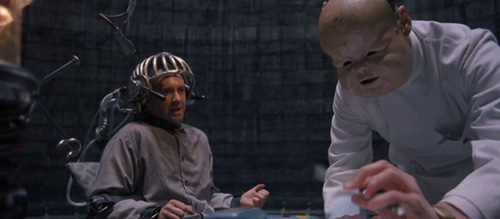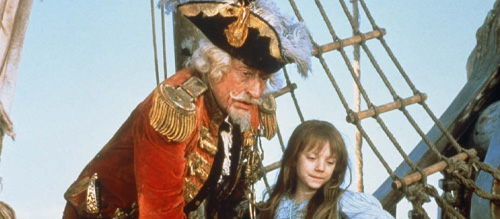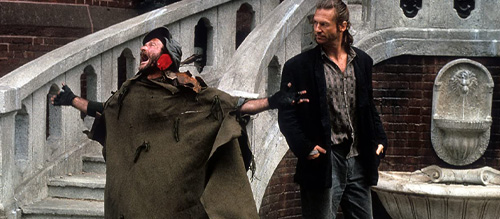Where to Start with Terry Gilliam
Before he was a cult favourite film director beloved by fans of steampunk, the surreal and tonal dissonance, the Minnesota-born, naturalised British Terry Gilliam was best-known as one sixth of the Monty Python comedy troupe. He didn’t write the sketches, but he frequently appeared as their most grotesque characters such as Cardinal Fang in “The Spanish Inquisition” and the jailor in Life of Brian, in addition to designing and animating all of the iconic cartoons that separated the skits in TV hit ‘Monty Python’s Flying Circus’.
Following various unfulfilling small-screen animation gigs, Gilliam eventually got his start directing features along with Terry Jones on 1975’s Monty Python and the Holy Grail, where he was largely responsible for the film’s atmospheric look and, to paraphrase one of his fellow Pythons, “making it look like a real movie”.
For four and a half decades, Terry Gilliam has maintained his highly distinctive aesthetic with retrofuturist elements for his science fiction, classical art influences for his fantasy, and phantasmagorical asides for everything else, his tonal style skewing towards the darkly comic and his go-to themes being anti-authoritarian. His boundless ambition, and habit of packing his films with more interesting ideas than can be comfortably contained in any given screen, is the reason his films are always interesting but many don’t quite stick the landing.
Gilliam’s projects have often not gone smoothly, from the production nightmare that was Baron Munchausen causing unforgivable stress, injury and trauma to several of its cast and crew, to Heath Ledger passing away midway through filming The Imaginarium of Doctor Parnassus, to The Man Who Killed Don Quixote infamously taking a full thirty years to actually make.
Of his 13 feature films to date, where should you start this mad odyssey? This is one recommended route into a unique artistic mind, probably accompanied by a rude animated guide (you’ll have to imagine that part). This is Where to Start with Terry Gilliam.
1. Brazil (1985)

Brazil (1985): A Cut Above the Rest
The tone is set by the first thing we see in Brazil, a TV ad with a man telling us “I want to talk to you about ducts”.
Terry Gilliam’s films are never lacking in imagination, but he tends to have two speed settings: surrealist comedy and pitch-black dystopia. 12 Monkeys, The Zero Theorem and most prominently this film (just one of many informal trilogies in his career) sit firmly in the latter camp.
We follow Sam Lowry (Jonathan Pryce) a drone in a nightmarish fascist bureaucracy who unexpectedly receives a promotion to the mysterious Information Retrieval Department. There, he unintentionally attracts the attention of sinister government agents as he searches for a beautiful woman he sees in his dreams every night.
Brazil blurs boundaries of reality from the start, our introduction to our protagonist presenting him soaring through the clouds looking like David Bowie dressed as a warrior angel. From then on it’s up for debate how much of Sam’s story actually occurs and what is just his own mind’s defence mechanism against acknowledging the horrible things that are happening to him.
Gilliam’s influences, like Fritz Lang’s Metropolis and George Orwell’s ‘1984’, are clear, but unusually for a dystopian sci-fi (in addition to the fact that it’s set at Christmas) this isn’t so much about actually overthrowing the tyrannical rulers as it is about the liberation of escaping them through your dreams. You have to think there’s a real-world parallel with Gilliam’s artistic hurdles and battles with studio executives here.
The system is awful, but there’s little chance of overcoming it even with such people like Robert DeNiro’s heating repair man-turned revolutionary Harry Tuttle (who may or may not be real). This is a world where a misfiled form can be a death sentence and the families of political prisoners are forced to cover the costs of their own interrogation, or “information retrieval”, with a payment plan. Brazil may be more comic than most movie dystopias, but it’s more bleak and hopeless in many ways as well.
Here Gilliam somehow even managed to make Michael Palin, famously the nicest of the Pythons, absolutely terrifying as an affable torturer, and there’s plenty of pitch-black, bordering on morbid humour amongst the satirically exaggerated social commentary and the duct-laden Art Deco mise-en-scéne.
2. The Adventures of Baron Munchausen (1988)

The Adventures of Baron Munchausen is Gilliam at his absolute battiest, his imagination firing on all cylinders. This shares a lot of the same DNA as Time Bandits, both being temporal-hopping road trips loosely linking fantasy vignettes starring character actors and comedians (here including Eric Idle, Oliver Reed and Robin Williams).
In Gilliam’s version of the frequently-adapted tall tale, the titular adventurer (John Neville) tells his remarkable, likely made-up story in a tumbledown theatre as the years roll back around him, reality responding to his colourful words as he recounts many fantastic adventures with companions of extraordinary skill.
A lot of Gilliam’s scripts work on a dream logic, and Munchausen makes for an inexplicably detailed and trippy dream. The story, while it can certainly be enchanting in its way, is episodic by nature and does go on a bit like any long and rambling story told by a grandparent.
Such imaginative sights presented to us include a Georges Méliès-esque trip to the moon to meet its disembodied floating head king (Williams), a visit to Vulcan (Reed) and Venus (Uma Thurman), and an epic battle against the Ottoman Empire.
You can tell it had a troubled production, because the strain of the performers and the joins between story segments all too often show, but that doesn’t make it any less fascinating to experience. The admittedly impressive battle scene that serves as the film’s finale wasn’t the only reason, but it was the the primary cause of the film going disastrously over schedule and at least $10 million over budget.
Eric Idle pretty much summed up the experience for audiences vs participants in the project: “You don’t ever want to be in them. Go and see them by all means – but to be in them, fucking madness!”
Even so, it’s just so beautiful to look at, its Oscar-nominated production design (from frequent Martin Scorsese collaborator Dante Ferretti), the vivid worlds imagined, the sheer scale, the still impressive effects, and Gilliam’s trademark sideshow designs, helping to make every frame exquisite.
3. The Fisher King (1991)

The Fisher King is Terry Gilliam’s most thematically complex and emotionally compelling film, and probably his most complete-feeling one as well; a modern Arthurian legend with surprises aplenty.
Acerbic but charming former late night DJ Jack Lucas (Jeff Bridges, basically playing Howard Stern) becomes increasingly fascinated by the apparently mentally ill homeless man Parry (Robin Williams) and the fairy tale quest he is undertaking.
For the first twenty minutes of the film, the ex-Python’s normal exuberant style is pretty dialled back, going for a grounded and gritty New York drama. But, pretty much perfectly in time with the first appearance of Robin Williams, his Gilliam-ness comes to the fore and the fantastical begins to seep through.
The director would not see his version of “Don Quixote” come to fruition for decades, so in the meantime he busied himself with a contemporary analogue that replaced Cervantes’ knight errant with a tenuous grip on reality with a modern man seriously down on his luck and an undiagnosed personality disorder.
Gilliam’s film worlds are usually more overtly theatrical, fantastical and over-the-top, but this feels like a real-world story seen through a magical realist lens. We genuinely feel for Parry and his trauma, and also want to see Jack leave his worst habits behind, both men helping each other become more complete as people.
That said, the individual images of a flaming red knight charging through a New York park in the dead of night, and the staggering achievement that is the meticulously choreographed and hopelessly romantic waltz around Grand Central Station (amazingly filmed over a single night), are enough reason to recommend the film almost by themselves.
Recommended for you: Where to Start with Paul Verhoeven
Terry Gilliam has left much behind since his days as the “other” Python, but since moving behind the camera and unlocking the dark, mischievous recesses of his mind, he has crafted two dozen undoubtedly flawed but undeniably unforgettable films. If you’re intrigued after watching all of the above and want to delve further, it’s an adventure worth pursuing; you’re bound to be entertainingly beguiled at the very least.

